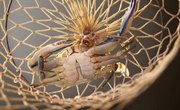
Dungeness crabs are the caviar of the Pacific Northwest. They have a range that extends from Mexico to Alaska but are primarily caught from San Francisco to Juneau. Chefs worldwide prize Dungeness crab for its soft white meat and distinct flavor. The common name "Dungeness" comes from a small fishing port and peninsula in northern Washington where crab fishing first became popular in the 1850s. Their scientific name is Cancer magister, or "chief crab" for their size. Catching Dungeness crab is an art form that anyone can learn with practice, a good location and an understanding of tides.
Tides and Crabs
Read any website devoted to crabbing and you'll find a plethora of different opinions about the best tides for catching Dungeness crabs. Some ardent crabbers claim low tide is better, while others say high tide is better. But it's best to believe the experts. According to the Oregon Department of Fish and Wildlife, a slack tide is best for crabbing. Slack tides, or slack water, occur at the period just before or just after a high or low tide -- when the water is slack and not moving. During slack tides, the crabs are not "fighting" the water so they are more likely to want food. Release your crab pots or lines about an hour before slack water time and then wait patiently.
Reading Tide Tables
If you don't know how to read a tide table, you won't know when to go crabbing. Tide tables are online for every state now; you can also order them or print them out if you don't have a reliable Internet connection. Tides move in roughly six- to seven-hour progressions from high to low tide, but most tide tables are only predictions. Sneaker waves, moon phases, changes in weather and geographical features change the tides, so always remain vigilant. High tides have a plus sign next to them in the tide chart, and low tides a minus sign.
State Laws
Crabbing laws are different for every state that allows the capture of Dungeness crab. Typical crab seasons close in the fall and are open the rest of the year, but the locations and times change for each state. The Puget Sound in Washington has specific laws for every area; some are closed all year long, others have a limited season and places like the Columbia River are open all the time. At the time of publication, Oregon prohibited crabbing only from October 16th to November 30th, but restricts the gender, size and amount you can catch. Alaska, California and British Columbia have separate laws as well, so make sure to check your local regulations before crabbing.
Identification of Dungeness Crabs
Catching crabs legally is about proper identification. If you don't know a Dungeness from a red and male from female, you can get yourself in big trouble. In most states, catching female Dungeness crab is illegal. Females have a different lower carapace than males, so bring a photo with you for easier identification. There are also specific size requirements. In Oregon, you can only keep 12 crabs per day over 5 ¾ inches; anything else is illegal, so take a measuring tape with you. Also, be careful when handling the crabs so that you don't crack or break their carapaces.
Warnings
Crabbing is a hobby that your entire family can enjoy. But you need to watch the weather reports, dress for both warm and cold weather, have proper identification and licenses, good equipment and food before going out into the ocean. Do your research before crabbing, and if you are unsure of locations, times or are not an experienced crabber, hire a guide. They have expert knowledge and can make your crabbing excursion better and more productive.
References
Writer Bio
Charles Roe started writing in 2009, specializing in technology, history, education and travel writing. His articles appear on eHow, Trails, Answerbag and other Web sites. Roe has a Master of Arts in history from the University of Cincinnati and a Diploma of English Language Teaching to Adults from Cambridge University.



